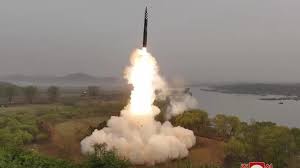North Korea Test-Fired Solid-Fuel Missiles:

North Korea test-fired an Intercontinental Ballistic Missile (ICBM) powered by solid fuel.
- Solid-fuel missiles do not need to be fuelled immediately ahead of launch.
- They are often easier and safer to operate, and require less logistical support.
- They are harder to detect and more survivable than liquid-fuel weapons.
- Solid propellants are a mixture of fuel and oxidiser.
- Metallic powders such as aluminium often serve as the fuel, and ammonium perchlorate, which is the salt of perchloric acid and ammonia, is the most common oxidiser.
- The fuel and oxidiser are bound together by a hard rubbery material and packed into a metal casing.
- When solid propellant burns, oxygen from the ammonium perchlorate combines with aluminium to generate enormous amounts of energy and temperatures of more than 5,000 degrees Fahrenheit (2,760 degrees Celsius), creating thrust and lifting the missile from the launch pad.




